On the Julian Calendar the February Revolution in Russia broke out on the 23 February. This revolution appeared to break out spontaneously, without any real leadership or formal planning. Russia had been suffering from a number of economic and social problems, which were compounded by the impact of the First World War. Bread rioters and industrial strikers were joined on the streets by disaffected soldiers from the city's garrison. As more and more troops deserted, and with loyal troops away at the front of the First World War, the city fell into chaos, leading to the overthrow of the Tsar.
The immediate result of the revolution was the abdication of Tsar Nicholas II, the end of the Romanov dynasty, and the end of the Russian Empire. The Tsar was replaced by a Russian Provisional Government under Prince Georgy Lvov. The Provisional Government was an alliance between liberals and socialists who wanted political reform. They set up a democratically-elected executive and constituent assembly. At the same time, socialists also formed the Petrograd Soviet, which ruled alongside the Provisional Government, an arrangement termed Dual Power.
The February Revolution was followed in the same year by the October Revolution, bringing Bolshevik rule and a change in Russia's social structure, and paving the way for the Soviet Union.
Antoni Zakrzewski: February Revolution
